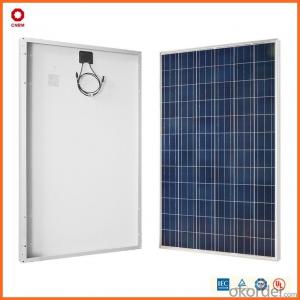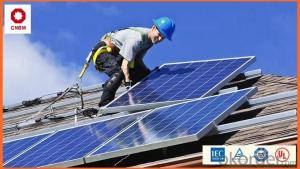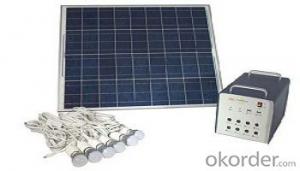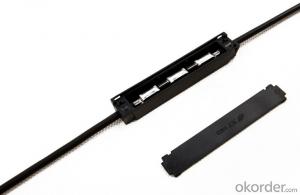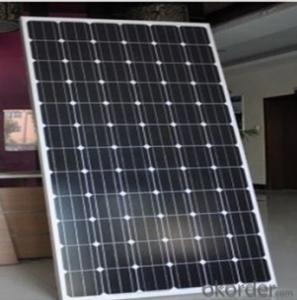50w Small Solar Panels in Stock China Manufacturer
- Loading Port:
- China main port
- Payment Terms:
- TT OR LC
- Min Order Qty:
- 1 watt
- Supply Capability:
- 10000000 watt/month
OKorder Service Pledge
OKorder Financial Service
You Might Also Like
Item specifice
Product Description:
Hot Sale !!! Quality and Safety of Small Poly Solar Panel 5w~150w
1. Rigorous quality control meets the highest international standards.
2. High-transmissivity low-iron tempered glass, strong aluminium frame.
3. Using UV-resistant silicon.
4. IS09001/14001/CE/TUV/UL
Warranties of Small Poly Solar Panel 35~85w
1. 10 years limited product warranty
2. 15 years at 90% of the minimal rated power output
3. 25 years at 80% of the minimal rated power output
Specification
Characteristics of Poly solar panels CNBM (245-320W) | |||||
Max Power Voltage Vmp(V) | 30.3 | 30.8 | 31.1 | 31.4 | 31.85 |
Max Power Current Imp(A) | 7.60 | 7.64 | 7.73 | 7.81 | 7.85 |
Open Circuit Voltage Voc(V) | 36.1 | 36.6 | 37 | 37.3 | 37.68 |
Short Circuit Current Isc(A) | 8.50 | 8.55 | 8.65 | 8.75 | 8.85 |
Max Power Pm(W) | 230W | 235W | 240W | 245W | 250W |
Temperature Coefficient of Cells Poly solar panels CNBM (245-320W) | |
NOCT | 45± 2 |
Temperature Coeffucients of Isc | 0.0492 |
Temperature Coeffucients of Voc | -0.3374 |
Temperature Coeffucients of Voc | -0.4677 |
Mechanical Data of Poly solar panels CNBM (245-320W) | |
Dimension | 1638 × 982 × 40 mm |
Weight | 19.5 kg |
No. of Cells and Connections | 60 (6 ×10) |
Tolerance | 0 ~ + 5 W |
Cell | Monocrystalline Cell 156 × 156 mm |
Packing | 624 Pcs/40ft(H) Container |
Limits of Poly solar panels CNBM (245-320W) | |
Operating Temperature | -40 to +85 |
Storage Temperature | -40 to +85 |
Max System Voltage | 1000VDC(IEC) / 600VDC(UL) |
Features of our products:
• High conversion efficiency mono/poly-crystalline amorphous silicon solar cells
• Modules incorporate high performance bypass diodes to minimize the power drop caused by shading
• High transmittance, low-iron tempered glass
• High performance EVA encapsulant to prevent destroying and water.
• AI frame: without screw, corner connection. 8 holes on the frame can be installed easily
• Good performance of preventing from atrocious weather such as wind and hails
• Certifications: CE IEC TUV VDE UL, Class I
• 10 years 90% power output warranty

Shipping of Small Poly Solar Panel 35~85w
By Sea | Delivery from Shanghai or Ningbo seaport |
By Air | Departure from Shanghai Pudong Airport |
By Express | Post by DHL, EMS, UPS, TNT. |
Features of our products:
• High conversion efficiency mono/poly-crystalline amorphous silicon solar cells
• Modules incorporate high performance bypass diodes to minimize the power drop caused by shading
• High transmittance, low-iron tempered glass
• High performance EVA encapsulant to prevent destroying and water.
• AI frame: without screw, corner connection. 8 holes on the frame can be installed easily
• Good performance of preventing from atrocious weather such as wind and hails
• Certifications: CE IEC TUV VDE UL, Class I
• 10 years 90% power output warranty
As a professional Solar Panel manufacturer and Supplier in China, we have our customers come around the whole world and our specialization has got a worldwide recognition. Meanwhile, with our superior quality, competitive price, prompt and excellent service, As main role in trade section of CNBM Group, CNBM International Corporation supplies products including Monocrystalline Solar Panel, Polycrystalline Solar Panel ( multicrystalline silicon Solar Panel) have received and enjoyed famous reputation in many countries and regions in the world.
- Q:How can solar energy systems reduce electricity bills?
- Solar energy systems can reduce electricity bills by generating electricity from sunlight, which can be used to power homes and businesses. By using solar power, individuals can rely less on traditional electricity sources, resulting in lower energy consumption from the grid. This leads to decreased reliance on utility companies and ultimately reduces electricity bills. Additionally, excess solar energy can be sold back to the grid, further offsetting electricity costs.
- Q:Can solar energy systems be installed in areas with extreme weather conditions?
- Solar energy systems can indeed be installed in regions with harsh weather conditions. Though extreme heat, cold, wind, or snow may potentially affect the efficiency of solar energy systems, modern solar technology has been engineered to endure such conditions. Solar panels are constructed using sturdy materials capable of withstanding high temperatures, freezing temperatures, and strong winds. Furthermore, solar panels undergo rigorous testing and certification to meet industry standards for durability and performance in various weather conditions. In areas with extreme heat, solar panels are designed to dissipate heat and maintain optimal efficiency. They are thoroughly tested to ensure they can sustain high temperatures without any damage or significant performance loss. Similarly, solar panels in areas with extreme cold are built to withstand freezing temperatures and can even generate electricity in snowy conditions. Some solar panels feature anti-reflective coatings to absorb more sunlight and expedite snow melting. Moreover, solar energy systems are commonly installed with robust mounting systems and structures capable of enduring strong winds or storms. These systems are engineered to ensure that solar panels remain securely attached to roofs or ground mounts, even in hurricane-prone or high-wind regions. Though the performance of solar energy systems may be slightly affected by extreme weather conditions, proper installation and design enable solar panels to still generate electricity and provide a dependable source of renewable energy in such areas. It is advisable to seek guidance from experienced solar installers or engineers who can evaluate the specific weather conditions of a given region and develop a solar energy system capable of withstanding those conditions.
- Q:Solar photovoltaic system
- Analysis of economic benefits: 50kW distributed photovoltaic PV power plant total operating period: 25 years of this project on average generating capacity: the annual average generating capacity of 200kWh: 73000kWh, 25 years of total power: 1825000kWh residential electricity price: 0.55 yuan /kWh local coal-fired power benchmark price: 0.44 yuan /kWh (the case): Total investment the total investment of about 450 thousand yuan, equivalent to 9 yuan / watt.
- Q:How often do solar panels need to be cleaned or maintained?
- Solar panels generally require minimal cleaning and maintenance. The frequency of cleaning depends on factors such as the location, weather conditions, and the level of dirt accumulation. In most cases, solar panels can be cleaned once or twice a year, while routine maintenance, such as checking for debris or damage, should be performed regularly.
- Q:Can solar energy systems be used in areas with high levels of dust or dirt?
- Yes, solar energy systems can be used in areas with high levels of dust or dirt. However, excessive accumulation of dust or dirt on solar panels can reduce their efficiency. Regular cleaning and maintenance of solar panels are essential to ensure optimal performance in such areas.
- Q:Can solar panels be installed on facades or windows?
- Yes, solar panels can be installed on facades or windows. Traditional solar panels are typically installed on rooftops to maximize sunlight exposure. However, there are now innovative solar technologies that allow for the integration of solar panels into building facades or windows. These technologies, known as building-integrated photovoltaics (BIPV) or building-applied photovoltaics (BAPV), enable the use of solar panels as part of the building's design and architecture. BIPV systems can be seamlessly integrated into the building's facade, replacing traditional building materials such as glass or cladding. This allows for the generation of solar energy while maintaining the aesthetic appeal of the building. BAPV systems, on the other hand, involve the installation of solar panels onto existing windows or as window coverings. These panels can be transparent or semi-transparent, allowing natural light to penetrate while generating electricity. Solar panels on facades or windows offer several advantages. Firstly, they provide additional surface area for solar energy generation, making the most of available space in urban environments where rooftop installations might be limited. Secondly, they can help to reduce a building's energy consumption by generating electricity on-site, thereby lowering reliance on the grid. Lastly, they contribute to the overall sustainability and eco-friendliness of the building, promoting renewable energy use and reducing carbon emissions. However, there are some considerations to keep in mind when installing solar panels on facades or windows. Factors such as the building's orientation, shading, and the quality of natural light need to be carefully evaluated to ensure optimal energy production. Additionally, the structural integrity of the building must be assessed to determine if it can support the additional weight of the solar panels. In conclusion, solar panels can indeed be installed on facades or windows through BIPV or BAPV systems. These innovative technologies offer numerous benefits such as increased energy generation, reduced energy consumption, and enhanced building sustainability. However, proper evaluation and planning are essential to ensure the effectiveness and feasibility of such installations.
- Q:Can solar energy systems be used in areas with frequent hurricanes?
- Yes, solar energy systems can be used in areas with frequent hurricanes. While it is true that hurricanes can cause damage to solar panels and other components of solar energy systems, there are measures that can be taken to mitigate these risks. Firstly, the design and installation of solar energy systems in hurricane-prone areas can be done to withstand high winds. This includes using stronger mounting systems, reinforced frames, and secure anchoring techniques. Additionally, the orientation and tilt angle of the panels can be optimized to minimize wind resistance. Furthermore, regular maintenance and inspections can help identify any potential issues or damage to the system before a hurricane hits. This allows for timely repairs or replacements, ensuring the system remains functional and safe during extreme weather events. In the event of a hurricane, it is important to have emergency procedures in place to secure the solar panels and other components. This can involve temporarily removing the panels and securing them indoors or utilizing protective covers to shield them from debris. Moreover, the use of microinverters or power optimizers in solar energy systems can enhance their resilience in hurricane-prone areas. These technologies allow each solar panel to operate independently, mitigating the impact of any damage to a single panel and preventing the entire system from shutting down. Lastly, solar energy systems can also contribute to the resilience of communities during and after hurricanes. With proper battery storage, solar systems can provide backup power during power outages, allowing essential services to continue operating and providing electricity for critical needs such as lighting, refrigeration, and medical equipment. Overall, while precautions need to be taken to ensure the durability and functionality of solar energy systems in hurricane-prone areas, they can be effectively used to harness clean and renewable energy even in the face of frequent hurricanes.
- Q:Can solar panels be installed on agricultural land without affecting crop production?
- Yes, solar panels can be installed on agricultural land without significantly affecting crop production. By utilizing techniques such as elevated panel mounting, rotational grazing, and optimizing panel spacing, farmers can ensure that solar panels are installed in a way that minimizes shading and allows crops to receive adequate sunlight. Additionally, solar panels can provide dual-use benefits by creating shaded environments that can benefit certain crops, reducing water evaporation and weed growth. Proper planning and design, along with open communication between solar developers and farmers, can help ensure that solar installations and agricultural activities can coexist harmoniously.
- Q:Can solar energy systems be used for powering sports stadiums?
- Yes, solar energy systems can be used for powering sports stadiums. Many sports stadiums around the world have already implemented solar energy systems to meet a portion or even all of their electricity needs. These systems typically consist of solar panels installed on the stadium roofs or in adjacent areas to harness sunlight and convert it into electricity. The generated energy can then be used to power the stadium's lighting, scoreboard, sound systems, and other electrical equipment. Utilizing solar energy helps reduce the carbon footprint of sports stadiums and promotes a more sustainable and environmentally friendly approach to powering large venues.
- Q:Can solar energy systems be used for powering electric vehicle component manufacturing plants?
- Yes, solar energy systems can be used to power electric vehicle component manufacturing plants. Solar panels can generate electricity that can be used directly or stored in batteries for later use. By utilizing solar energy, these plants can reduce their reliance on fossil fuels, lower their carbon footprint, and contribute to a more sustainable manufacturing process for electric vehicles.
1. Manufacturer Overview |
|
|---|---|
| Location | |
| Year Established | |
| Annual Output Value | |
| Main Markets | |
| Company Certifications | |
2. Manufacturer Certificates |
|
|---|---|
| a) Certification Name | |
| Range | |
| Reference | |
| Validity Period | |
3. Manufacturer Capability |
|
|---|---|
| a)Trade Capacity | |
| Nearest Port | |
| Export Percentage | |
| No.of Employees in Trade Department | |
| Language Spoken: | |
| b)Factory Information | |
| Factory Size: | |
| No. of Production Lines | |
| Contract Manufacturing | |
| Product Price Range | |
Send your message to us
50w Small Solar Panels in Stock China Manufacturer
- Loading Port:
- China main port
- Payment Terms:
- TT OR LC
- Min Order Qty:
- 1 watt
- Supply Capability:
- 10000000 watt/month
OKorder Service Pledge
OKorder Financial Service
Similar products
New products
Hot products
Hot Searches
Related keywords
